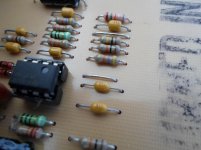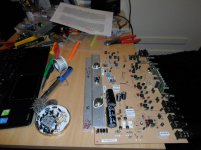The tan ones were cheapo 50v ceramic power bypass caps. Several were blown open in my 1998 PV-1.3k. I doubt if those were CG0. I replaced with salvage caps from a PCAT power supply with a higher voltage rating.
The green things looking like resistors might also be ceramic capacitors, check the schematic. I had some of those blown too, in the DDT and VI limiter circuits. 50 v rating in my amp. I replaced with 200 v rated caps +-20% so they won't blow the next time the output transistors do. The gold band indicates a more precise cap than the tan bypass caps, I think. I used film caps; they stuck up a little more than the green ones but there was room. CG0 is hard to buy from my usual vendors, no sense paying $10 freight to get a $.80 part when a $2 one will do.
The green things looking like resistors might also be ceramic capacitors, check the schematic. I had some of those blown too, in the DDT and VI limiter circuits. 50 v rating in my amp. I replaced with 200 v rated caps +-20% so they won't blow the next time the output transistors do. The gold band indicates a more precise cap than the tan bypass caps, I think. I used film caps; they stuck up a little more than the green ones but there was room. CG0 is hard to buy from my usual vendors, no sense paying $10 freight to get a $.80 part when a $2 one will do.
Last edited:
I thought they were bit budget using ceramic, i just swapped them all out except the resistor looking one because they were such low value, and left the power supply ones.
not sure what it is with peavey's blowing up, my friends transistor one cooked as well, im not sure if he was using headphones with it. they sound pretty good strong sound for a solidstate, i was amazed at how many op's the used to make it. its got ten 4558 's in it, seems like alot.
not sure what it is with peavey's blowing up, my friends transistor one cooked as well, im not sure if he was using headphones with it. they sound pretty good strong sound for a solidstate, i was amazed at how many op's the used to make it. its got ten 4558 's in it, seems like alot.
Attachments
What Peavey is this?I thought they were bit budget using ceramic, i just swapped them all out except the resistor looking one because they were such low value, and left the power supply ones.
not sure what it is with peavey's blowing up, my friends transistor one cooked as well, im not sure if he was using headphones with it. they sound pretty good strong sound for a solidstate, i was amazed at how many op's the used to make it. its got ten 4558 's in it, seems like alot.
Post #1, he says a TKO from 1993. Looking at the photo, I suspect it is a TKO115 '92 model. Schematic here:
http://bmamps.com/Schematics/Peavey/Peavey_TKO_115_(7-92)_Schematics.pdf
Peavey uses them because they do the job up to spec, and are reliable.
As to "what is with Peaveys blowing up", well, there are so MANY of them out there, you are going to run into one failing now and then. a 25 year old amp can be forgiven needing some service every so often.
http://bmamps.com/Schematics/Peavey/Peavey_TKO_115_(7-92)_Schematics.pdf
Peavey uses them because they do the job up to spec, and are reliable.
As to "what is with Peaveys blowing up", well, there are so MANY of them out there, you are going to run into one failing now and then. a 25 year old amp can be forgiven needing some service every so often.
i like the sound of the amps they have good round kind of 80's sound, almost kind of modulated when picking single notes. I'm not sure if the newer ones manufactured in china have the same layout because some people say these amps are really good and others would waste there time with them, so im not sure if they're like two different amps (the early and later ones).
Film caps and OPA2134 opamps (OPA1642 if you can deal with SOICs) would be a good upgrade.
Last edited:
Film caps and OPA2134 opamps (OPA1642 if you can deal with SOICs) would be a good upgrade.
Why a 'good upgrade'?
i swapped the ceramics out the other night, i was thinking about OPA2134, i reckon the JRC4588 are a bit dirty for some stuff and the NE5532 are just to bright and clean sounding. all the ic's have factory sockets so pretty easy swap.Film caps and OPA2134 opamps (OPA1642 if you can deal with SOICs) would be a good upgrade.
i think the film caps have a deeper response if that makes sense,Why a 'good upgrade'?
I just bought the amp last week and it was sounding pretty flat compare to my friends i used to play through about ten or so years ago (his hadnt had much use), so thought i would do the electrolytics, there was only about two films caps in the whole amp so thought film would be an improvement.
i replaced the polarized and ceramics at the same time so im not sure what sorted it.
its sounds much better after about three hours of playing, not sue if i will pull it apart again and swap the ops, the designers might get peeved if i change the sound of their amp they spent years developing. they would probably tell me to go build my own
OPA1642 opamps have about 18 db less noise and 44 db less distortion than the RC4558s that are currently in the amp.Why a 'good upgrade'?
Power bypass caps are best as ceramic, for stomping out out high frequency transients like bouncer radios(transmit), cordless mikes, & cell phones. 4558 are not particular of power supply cleanliness due to the slow slew rate spec, interesting you got by with film for the little tan bypass caps.
Peavey PA amps blow up because people pull the 1/4 phone plug out part way in the dark on stage, and short the output transistors. Guitar amps, I don't know, maybe too much crunch pedal in combination with volume 11. I'm a keyboard player, PA amps all the way in my music room since I melted solder and set fire to a 120 W hifi amp with a 3.5 hour rehearsal at ~10 Watts.
Most guitar players play at the same volume +-10 db; great signal to noise using a $6 OPA IC is kind of silly in that service IMHO. If more volume change than that is required the sound man will take care of it in the house mix.
I'm not looking up OPA1642 datasheet since OPA anything costs so much, but if slew rate is a lot faster than 8 v/microsec, you'd be safer against self oscillation substituting a NE5532 if the +-15 v supply will stand the doubled current demand. My goto op amp is the MC33078 at $.38 each but you have to have to have local power supply bypass and ceramic caps across the feedback resistor (33 pf) to avoid self oscillation on those fast slew rate parts. I like the faster amp IC because keyboard has so much more high frequency content than guitar.
Peavey PA amps blow up because people pull the 1/4 phone plug out part way in the dark on stage, and short the output transistors. Guitar amps, I don't know, maybe too much crunch pedal in combination with volume 11. I'm a keyboard player, PA amps all the way in my music room since I melted solder and set fire to a 120 W hifi amp with a 3.5 hour rehearsal at ~10 Watts.
Most guitar players play at the same volume +-10 db; great signal to noise using a $6 OPA IC is kind of silly in that service IMHO. If more volume change than that is required the sound man will take care of it in the house mix.
I'm not looking up OPA1642 datasheet since OPA anything costs so much, but if slew rate is a lot faster than 8 v/microsec, you'd be safer against self oscillation substituting a NE5532 if the +-15 v supply will stand the doubled current demand. My goto op amp is the MC33078 at $.38 each but you have to have to have local power supply bypass and ceramic caps across the feedback resistor (33 pf) to avoid self oscillation on those fast slew rate parts. I like the faster amp IC because keyboard has so much more high frequency content than guitar.
Last edited:
OPA1642s at Mouser=$3.33 each; <$3 if ya buy 10. Slew Rate=20v/usec.great signal to noise using a $6 OPA IC is kind of silly in that service IMHO. If more volume change than that is required the sound man will take care of it in the house mix.
I'm not looking up OPA1642 datasheet since OPA anything costs so much, but if slew rate is a lot faster than 8 v/microsec, you'd be safer against self oscillation substituting a NE5532 if the +-15 v supply will stand the doubled current demand. My goto op amp is the MC33078 at $.38 each but you have to have to have local power supply bypass and ceramic caps across the feedback resistor (33 pf) to avoid self oscillation on those fast slew rate parts. I like the faster amp IC because keyboard has so much more high frequency content than guitar.
In a guitar amp, the necessary high impedance due to the pickup and tone stacks SCREAM for a FET-type opamp (ala 1642) and NOT a bipolar type like the NE5532 OR MC33078. You are correct that the faster opamps need to be careful of oscillation; the schematic shows that several of the stages HAVE sufficient feedback caps. Not seeing any power supply bypass caps, though--sort of surprising because many cheaper PV amps DO have supply bypassing at each opamp. So it would need those. Current demand would be about 45% additional, not double. The shown +/- 15v supply is pretty poor.
Power bypass caps are best as ceramic, for stomping out out high frequency transients like bouncer radios(transmit), cordless mikes, & cell phones. 4558 are not particular of power supply cleanliness due to the slow slew rate spec, interesting you got by with film for the little tan bypass caps.
Peavey PA amps blow up because people pull the 1/4 phone plug out part way in the dark on stage, and short the output transistors.
hello,
I left the really low value ceramics that look like resistors in because i didnt have that lower value films. I wondered about the headphones because the only amp i ever killed was a 45 solidstate practice amp before i new anything about amps and its was when i started using headphones in it.
- Status
- Not open for further replies.
- Home
- Live Sound
- Instruments and Amps
- peavy capcitor identification help please

